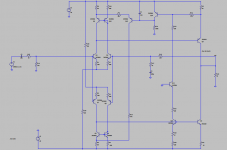current source
A simulation should be done to check for gotchas, but, ya, a resistor could be used. But a resistor means the LTP current is a function of supply voltage, which is an issue with predictability, and some will argue PSRR.
A simulation should be done to check for gotchas, but, ya, a resistor could be used. But a resistor means the LTP current is a function of supply voltage, which is an issue with predictability, and some will argue PSRR.
PSRR shouldn't be a concern. SMPS comes in handy there. I wish I could make the current circuit function as-is. It has a sound to it that's very ghostly. Image depth and instrument focus is fantastic. Even after all the explanations, I still don't see how the VAS can't conduct. Plus I have two of them that work just fine.
Its biasing is not determined. Bob Cordell explains why much better than I could ever do.Even after all the explanations, I still don't see how the VAS can't conduct
I haven't bought the book yet.
As far I can understand transistor bias, it can be determined by a base voltage >Vbe to turn it on and emitter degeneration can stabilize it. Maybe I'm getting to old to learn anything new.
As far I can understand transistor bias, it can be determined by a base voltage >Vbe to turn it on and emitter degeneration can stabilize it. Maybe I'm getting to old to learn anything new.
yet another variation
For the sake of others that will find this useful, here is another circuit for regulating the VAS current. It has optional bits that for consideration by those who understand them like the efforts to reduce heat and voltage on certain transistors.
The capacitor C3 is actually optional but it improves THD bit. A few interesting points are:
1. The DC and AC balance do not occur at the same point.
2. The THD can be good but not spectacular, which implies that a symmetric IPS is of little value.
3. A typical current mirror circuit has a natural offset that feeds the VAS, probably due to losses in the current mirror. This offset is too much for a Darlington VAS so any Darlington VAS current control has to range into the negative.
So this is fun to play with but the lesson is that it's not something I would build. I do like a Push-Pull VAS, especially for driving MOSFETs but that would be a VAS that is a LTP and a current mirror, from a single LTP IPS.
For the sake of others that will find this useful, here is another circuit for regulating the VAS current. It has optional bits that for consideration by those who understand them like the efforts to reduce heat and voltage on certain transistors.
The capacitor C3 is actually optional but it improves THD bit. A few interesting points are:
1. The DC and AC balance do not occur at the same point.
2. The THD can be good but not spectacular, which implies that a symmetric IPS is of little value.
3. A typical current mirror circuit has a natural offset that feeds the VAS, probably due to losses in the current mirror. This offset is too much for a Darlington VAS so any Darlington VAS current control has to range into the negative.
So this is fun to play with but the lesson is that it's not something I would build. I do like a Push-Pull VAS, especially for driving MOSFETs but that would be a VAS that is a LTP and a current mirror, from a single LTP IPS.
Attachments
- Home
- Amplifiers
- Solid State
- Trouble with HEXFETS
